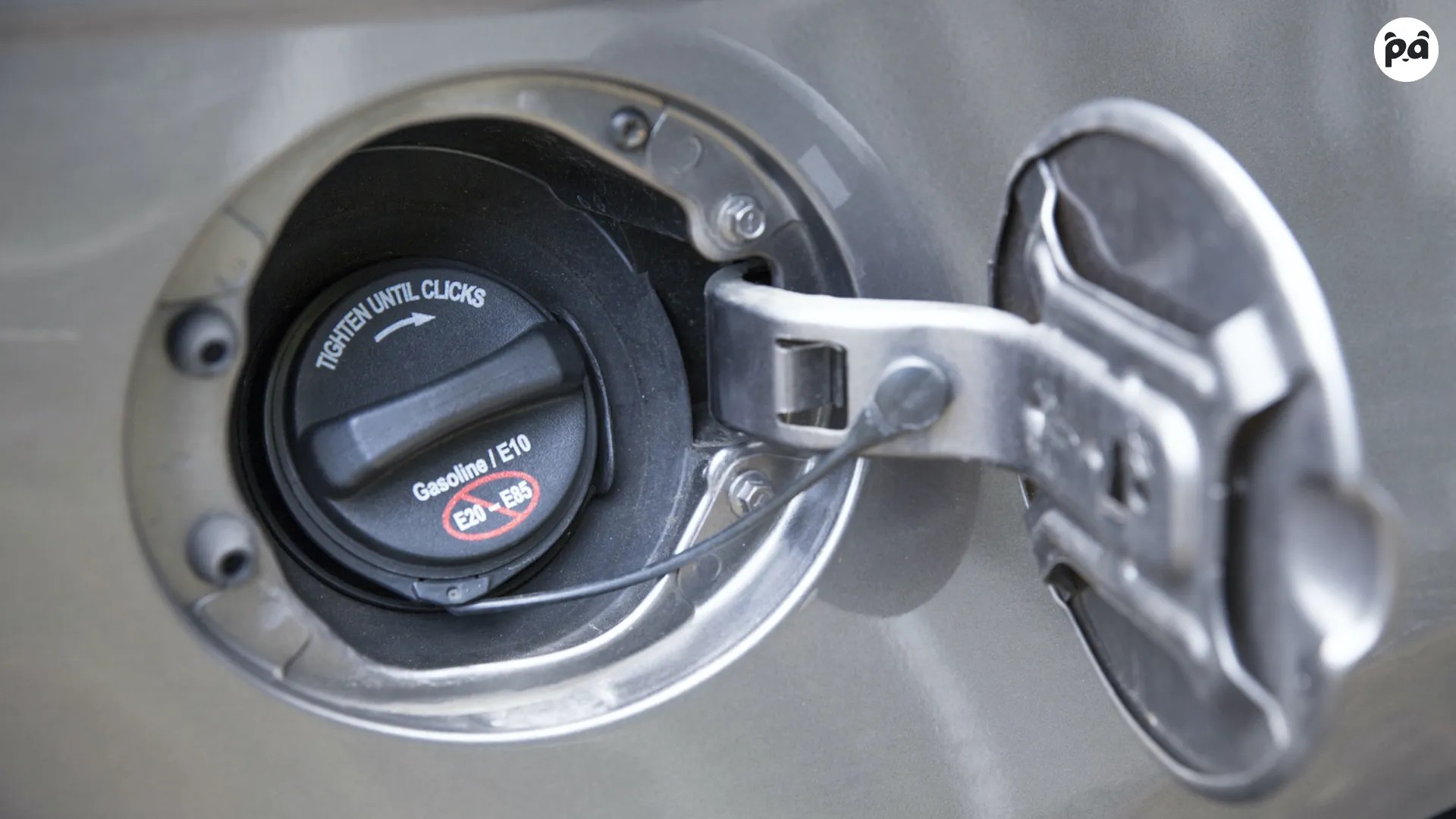Every car owner dreads that moment: the check engine light illuminating on your dashboard. It can be triggered by a multitude of issues, and one of the more common culprits is the P0455 code. If you’ve encountered this code, don’t panic. This comprehensive guide, crafted by an auto repair expert from obd-de.com, will help you understand, diagnose, and fix the P0455 code, getting you back on the road with confidence.
This article is designed to be your master resource for tackling the P0455 code. We will break down the complexities of this error, explain what it signifies for your vehicle, and provide you with the knowledge to effectively address the problem. Whether you’re a seasoned gearhead or a complete novice, this guide will steer you through the world of automotive diagnostics and repairs related to the P0455 fault code.
Decoding the P0455 Code: EVAP System Explained
The P0455 code is more than just a random series of numbers and letters. It’s a direct signal from your car’s onboard computer, specifically its Engine Control Unit (ECU), indicating a problem within the Evaporative Emissions (EVAP) Control System. But what does this mean for your car and your driving experience?
P0455 Code: Signifying a Large Leak
In simple terms, the P0455 code signifies that your vehicle is experiencing a “large leak” within its EVAP system. This system is designed to prevent harmful fuel vapors from escaping into the atmosphere. A large leak means the system isn’t doing its job effectively, which can lead to several issues.
Why is the P0455 Code Important? Environmental and Performance Impacts
The P0455 code is not just about a warning light on your dashboard. It has implications for both your vehicle’s performance and the environment.
Firstly, uncontrolled fuel vapor emissions are harmful pollutants. Modern vehicles are equipped with EVAP systems to comply with environmental regulations designed to reduce smog and air pollution. Ignoring a P0455 code can contribute to environmental damage and may even lead to failing emissions tests in regulated areas.
Secondly, while a P0455 code might not immediately cause catastrophic engine failure, it can affect your car’s efficiency and performance over time. The EVAP system plays a role in fuel management, and a leak can disrupt this balance.
Deep Dive into the EVAP System: How It Works
To effectively diagnose and fix a P0455 code, understanding the EVAP system is crucial.
The Purpose of the EVAP System
The Evaporative Emission Control System (EVAP) is designed to capture gasoline vapors that evaporate from the fuel tank. Instead of releasing these vapors into the air, the EVAP system traps them and then purges them into the engine to be burned during normal combustion. This process significantly reduces hydrocarbon emissions from your vehicle.
Key Components of the EVAP System
The EVAP system is comprised of several key components working together:
- Fuel Tank: The starting point for fuel vapors.
- Charcoal Canister: This is the heart of the EVAP system. The charcoal canister stores fuel vapors until they can be purged into the engine.
- Purge Valve (Purge Solenoid): Controls the flow of fuel vapors from the charcoal canister to the engine intake manifold. It opens at specific times, allowing vacuum from the engine to draw the stored vapors for combustion.
- Vent Valve (Vent Solenoid): Allows fresh air to enter the EVAP system, typically located near the charcoal canister. It plays a crucial role in system pressure and leak detection.
- Pressure Sensor: Monitors the pressure within the EVAP system to ensure it’s sealed and functioning correctly.
- Fuel Cap: Seals the fuel tank and is a critical part of the EVAP system’s integrity.
- Hoses and Lines: Connect all the components, allowing vapor flow and pressure regulation.
P0455 Code Meaning: Breaking Down the Definition
The P0455 diagnostic trouble code (DTC) is specifically defined as “Evaporative Emission Control System Leak Detected (Large Leak).”
Technical and Simple Explanation of P0455
Technically: The ECU monitors the EVAP system for leaks by applying a vacuum and checking for pressure changes. When the system detects a significant pressure loss, indicating a large leak, it triggers the P0455 code and illuminates the check engine light.
Simply: Imagine the EVAP system as a closed container meant to hold vapors. The P0455 code is like your car telling you, “Hey, there’s a big hole in this container, and it’s leaking more than it should.” This “hole” prevents the system from maintaining the necessary pressure and capturing fuel vapors effectively.
Recognizing the Symptoms of a P0455 Code
The P0455 code often manifests with noticeable symptoms that can alert you to a problem even before you scan for codes.
Common Symptoms Associated with P0455
-
Check Engine Light is On: This is the most direct and obvious symptom. The check engine light will illuminate on your dashboard to signal a problem detected by the ECU.
-
Fuel Odor: You might smell gasoline fumes, especially around the fuel tank or near the rear of the vehicle. This is a strong indicator of fuel vapors escaping due to a leak in the EVAP system.
-
Decreased Fuel Economy: A large leak can lead to fuel evaporation, which means you’re losing fuel that should be used by the engine. This can result in a noticeable drop in your car’s miles per gallon (MPG).
-
Difficulty Starting or Stalling: In some cases, a large EVAP leak can affect the air-fuel mixture entering the engine, potentially causing hard starts or even engine stalling, although this is less common with P0455 than with other EVAP codes.
Common Causes of the P0455 Code: What Triggers It?
Understanding the potential causes of a P0455 code is the first step in effective diagnosis.
Top Reasons for a P0455 Code
-
Loose or Missing Gas Cap: This is the most frequent and simplest cause. A gas cap that isn’t tightened properly, or is damaged or missing, will break the EVAP system seal and cause a large leak.
-
Faulty or Damaged Gas Cap Seal: Even if the gas cap is present and tightened, the rubber seal on the cap itself can deteriorate over time, leading to leaks.
-
Cracked or Damaged EVAP Hoses and Lines: The rubber hoses and plastic lines that make up the EVAP system can become brittle, cracked, or disconnected due to age, heat, or physical damage.
-
Malfunctioning Purge Valve or Vent Valve: These solenoids can fail to open or close correctly, leading to pressure imbalances and leaks within the EVAP system. They may stick open, causing a continuous leak.
-
Damaged Charcoal Canister: The charcoal canister itself can be cracked or damaged, preventing it from properly storing fuel vapors. Saturation or blockage of the canister can also cause issues, although less directly related to a “large leak.”
-
Faulty Fuel Tank Pressure Sensor: While less common for a P0455 directly indicating a large leak, a failing pressure sensor can sometimes give false readings, triggering the code even if a physical leak is not the primary issue.
-
Overfilling the Fuel Tank: Repeatedly overfilling your gas tank can force liquid fuel into the EVAP system, potentially damaging components, especially the charcoal canister, and leading to leaks over time.
Brand and Model Specific P0455 Code Issues
While the P0455 code is universal across OBD-II compliant vehicles, some makes and models may have specific tendencies or common weak points within their EVAP systems.
Are P0455 Codes More Common in Certain Vehicles?
Certain manufacturers might use specific EVAP system component designs or materials that are more prone to failure in certain climates or driving conditions. For example, vehicles frequently driven in harsh winter conditions with road salt might experience faster corrosion of EVAP system components. Similarly, vehicles with EVAP systems located in vulnerable areas under the chassis might be more susceptible to damage from road debris.
It’s always beneficial to research common issues specific to your car’s make and model when troubleshooting a P0455 code. Online forums dedicated to your vehicle brand can provide valuable insights from other owners who have experienced similar problems.
Diagnosing the P0455 Code: A Step-by-Step Approach
Diagnosing a P0455 code can be systematic, starting with the simplest and most common causes and progressing to more complex component checks.
Step-by-Step Diagnostic Procedure for P0455
-
Check the Gas Cap: This is always the first step. Ensure the gas cap is present, properly tightened until it clicks, and that the rubber seal looks to be in good condition. Try removing and reinstalling it. Clear the code with an OBD-II scanner and see if it returns.
-
Visual Inspection of EVAP System Hoses: Carefully inspect all accessible EVAP hoses and lines in the engine bay and underneath the vehicle. Look for cracks, breaks, disconnections, or signs of damage. Pay attention to areas near heat sources or moving parts.
-
Inspect the Charcoal Canister Area: Examine the charcoal canister and surrounding lines for any visible damage, cracks, or fuel leaks. Sometimes, physical impacts can damage the canister.
-
Listen for Hissing Sounds: With the engine running (and safely parked), listen around the fuel tank, gas cap, and EVAP system components for any hissing sounds, which could indicate a vacuum leak.
-
OBD-II Scanner Data: Use an OBD-II scanner to read the P0455 code and any Freeze Frame data. Freeze Frame data captures engine conditions when the code was set, which can sometimes provide clues. Clear the code after initial checks to see if it reappears.
-
Smoke Test: A smoke test is a highly effective method to pinpoint EVAP leaks. A professional mechanic can introduce smoke into the EVAP system and observe where smoke escapes, revealing the location of the leak.
-
Component Testing (Purge/Vent Valves, Pressure Sensor): If visual inspection and smoke tests don’t reveal the leak, individual EVAP system components like the purge valve, vent valve, and pressure sensor might need to be tested for proper function using a multimeter or specialized diagnostic tools.
-
Professional Diagnosis: If you are uncomfortable performing these steps or cannot locate the leak, it’s best to take your vehicle to a qualified mechanic. They have the expertise, tools, and experience to accurately diagnose and repair EVAP system issues.
Conclusion: Resolving the P0455 Code and Maintaining Your Vehicle
The P0455 code, while potentially concerning with its “large leak” designation, is often resolvable, frequently starting with a simple check of your gas cap. By understanding what the P0455 code means, the function of your EVAP system, and following a systematic diagnostic approach, you can confidently tackle this issue.
Remember, addressing a P0455 code is not just about turning off the check engine light. It’s about ensuring your vehicle operates efficiently, minimizes harmful emissions, and contributes to a cleaner environment. Don’t hesitate to seek professional help when needed, but with the knowledge gained here, you’re well-equipped to start the troubleshooting journey and get your car back to its optimal condition.
FAQ: Quick Answers about the P0455 Code
Q: Can I drive my car with a P0455 code?
A: Yes, you can generally drive with a P0455 code, but it’s not recommended to ignore it for extended periods. While it might not cause immediate engine damage, the underlying leak can worsen over time, affect fuel economy, and contribute to environmental pollution. Address it as soon as practical.
Q: Will replacing the gas cap fix a P0455 code?
A: Yes, in many cases, especially if the gas cap is loose, old, or damaged, replacing it can resolve a P0455 code. It’s an inexpensive and easy first step in troubleshooting.
Q: How much does it cost to fix a P0455 code?
A: The cost to fix a P0455 code varies widely depending on the cause. A gas cap replacement might cost as little as $20-$50. However, if the issue is a faulty valve, damaged canister, or requires extensive smoke testing and component diagnosis, the cost could range from $100 to $500 or more. Getting a proper diagnosis from a mechanic is crucial for an accurate cost estimate.

